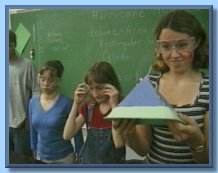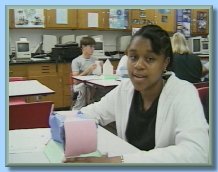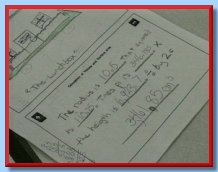This Activity introduces students to some basic design techniques that can prevent or reduce damage to structures caused by high or hurricane force winds. (And after some of the houses are ripped to shreds or blown away, it provides some teachable moments for emergency preparedness procedures.) New materials are constantly being developed and used in the construction of new homes, but there are some simple yet effective ways to reinforce existing homes:
Student Worksheets 4.2.3 Activity self-evaluation form (per student)
Objectives
Students will build a house that will be tested against "hurricane force winds."
Students will learn what design features make a house more or less resistant to strong winds.
Students will practice math skills of calculating surface area and volume.
Students will use problem-solving techniques.
|

|
Explain/Explore
Day 1: Distribute Student Worksheets 4.2.1, 4.2.2, and 4.2.3. Review the procedures and timetable. Explain that student teams will have the remainder of the first day's class and one additional class period to discuss, plan and design their house using the materials provided. Day 1 can be a practice run for the "apprentice builders." If at the end of the class, they feel their house is "vulnerable" they will have day 2 (as "experienced builders") to redesign and build a new design.
Ask students how the size or surface area of their house will affect its ability to withstand strong winds. Explain that they must calculate the volume of their houses to meet the 1,500 cubic cm target, which must be the same for all teams. Review the formulas. If the volume of the house is not shown to be very close to the 1,500 cubic centimeters through appropriately labeled explanatory diagrams as on Worksheet 4.2.1 they must rebuild their house on day 2. Surface area will vary according to each teams' design; remind them that for the purposes of this Activity, the house's surface area is the sum of the area of each side and the roof, but excludes the base. If necessary, give students samples of each shape and have them calculate surface area and volume. Explain that the surface area will be considered after the houses are tested by the "hurricane force" winds to answer the question, "Did the surface area affect the success of house to withstand the winds?"

|
Day 2: Provide new materials for those who need it. They will have one class period to complete their house and have it ready for testing by leaf blower. To compare designs all houses should be tested on the same day.
|
Before "blowing away the houses:" if you have a wind gauge, stand a distance away from where the houses will be held. Starting at the edge of the classroom indicate with masking tape on the floor where the wind is "tropical depression" (<39 mph), "tropical storm" (39-73 mph), "hurricane strength" (>74 mph) and the strongest. (Some leaf blowers can blow as fast as 94 mph. On new leaf blowers you may even find "miles per hour" indcated on the box.) The final tape mark will be just inches away from where the house will be held. If you do not have a wind gauge, simply mark a place for 'light,' 'mild' and 'strong' winds.
Day 3: Testing the Houses. Using the leaf blower, you or the parent-volunteer should stand at the "light", then "mild", then "strong wind" masking tape marks. Aim the leaf blower at the house while one of the student team members turns the house with extended arms to simulate the swirling winds of a hurricane as it makes landfall. Have each team record the results (damage sustained within X minutes at Y wind condition, or survival for X minutes at the strongest wind position) on the Worksheet or in WEATHERLogs.
Grade each team according to the Scoring rubric provided.
Please note that this Activity merely simulates hurricane force winds and construction techniques. "Construction paper," despite its name, does not scale to sheetrock and 2 x 10's and roof shingles. But just as the manufacturers of leaf blowers think it's a good sales gimmick to rate their product by its hurricane force, we think students will be excited and impressed by this Activity, even without precise correspondence to real wind velocities and building materials.
Expand/Adapt/Connect
"What do you get when you cross a styrofoam tray, straws, construction paper and a leaf blower in a classroom? You get a localized hurricane trying to topple model houses." This is how a local TV meteorologist described the "Hurricane Houses" Activity when it was first implemented in a Florida high school classroom. You might also invite your local weatherperson to your school: we think they'll be interested to see how their professional interests have been incorporated into the curriculum! And your school might get some welcome local exposure.
As a class activity, have students note the strongest winds each house could withstand, and plot these results against volume and the surface area of each design. Is there a correlation between design and the strength of the winds the house could withstand? If you can videotape the results, students from each class can view the designs and results from other classes. What design features seem to prove more effective than others? How might those "construction paper" principles apply to real world building techniques.
Have students do the same assignment but vary the materials. Students can bring in materials from home. Who can build the most hurricane proof home if there is a free choice of materials?
Consider having students re-test some of the surviving houses during a school Open House event or at a science fair Expo. This is a great way to involve parents and other faculty in the excitement of this "real science" activity.
"HURRICANE...derived from 'hurican', the Carib god of evil...
alternative spellings: foracan, foracane, furacana, furacane, furicane, furicano, haracana, harauncana, haraucane, haroucana, harrycain, hauracane, haurachana, herican, hericane, hericano, herocane, herricao, herycano, heuricane, hiracano, hirecano, hurac[s]n, huracano, hurican, hurleblast, hurlecan, hurlecano, hurlicano, hurrican, hurricano, hyrracano, urycan, hyrricano, jimmycane, oraucan, uracan, uracano"
From the "Glossary of Meteorology": thanks to Chris Landsea, NOAA/OAR/AOML
Suggested URLs for Activity 4.2 Hurricane Houses
National Hurricane Center. Latest official warnings, and general information about hurricanes.
http://www.nhc.noaa.gov/
"Against the Wind" This booklet and a video is also available from local Red Cross chapters.
http://www.redcross.org/services/disaster/beprepared/Agnstwd.pdf
"Is your Home Protected from Hurricane Disaster: A Homeowner's Guide to Hurricane Retrofit" Prepared by the Institute for Business and Home Safety
http://www.ibhs.org/
FEMA Online Library: links to FEMA publications including "Against the Wind" and preparedness guides.
http://www.fema.gov/library/lib07.htm
University of Wisconsin, Madison: Tropical storm website with latest warnings, information, images and movies for every part of the world.
http://cimss.ssec.wisc.edu/tropic/tropic.html
Classroom Videos / In-service Videos / Implementation Guide / Hands-On Activities / Worksheets / Website / National Standards






![]()